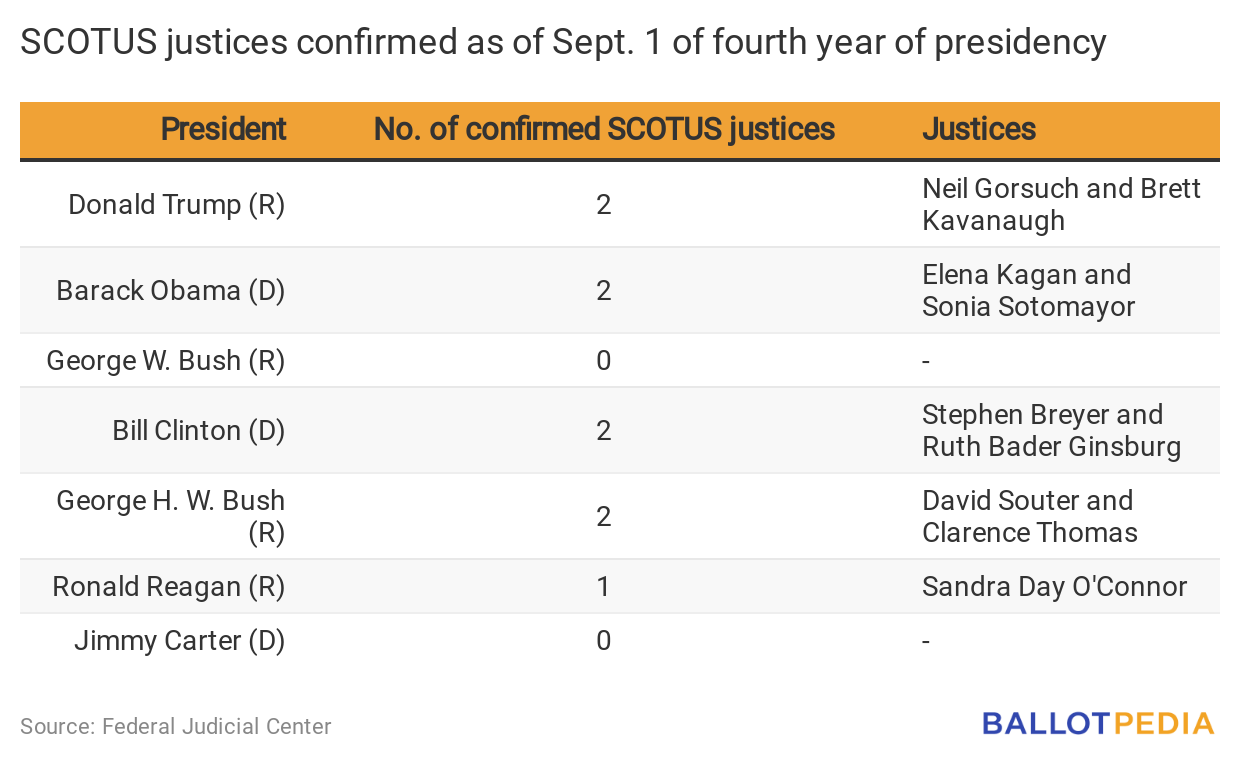Welcome to the September 30 special edition of Bold Justice, Ballotpedia’s newsletter about the Supreme Court of the United States (SCOTUS) and other judicial happenings around the U.S. Keep up to date with Amy Coney Barrett’s nomination by following us on Twitter or subscribing to the Daily Brew.
About Amy Coney Barrett
Barrett is a judge on the U.S. Court of Appeals for the 7th Circuit. Trump nominated her to the 7th Circuit on May 8, 2017. The Senate voted 55-43 to confirm her appointment on October 31, 2017. Barrett clerked for U.S. Supreme Court Associate Justice Antonin Scalia from 1998 to 1999. Barrett earned her bachelor’s degree, magna cum laude, in English literature from Rhodes College in 1994 and her J.D., summa cum laude, from Notre Dame Law School in 1997. She was awarded the law school’s Hoynes Prize, which is the law school’s highest honor. Barrett was executive editor of the Notre Dame Law Review.
Process to fill the seatAlthough the rules for appointing and confirming a U.S. Supreme Court justice are set out in the U.S. Constitution, the process for choosing nominees is not codified in law. Past presidents have received lists of recommendations from the White House counsel, the attorney general and lawyers in the Justice Department’s Office of Legal Counsel. Individuals and organizations outside of the administration also influence the nominating process. The American Bar Association (ABA), through its 15-member Committee on the Federal Judiciary, rates nominees as “well qualified,” “qualified” or “not qualified.” Others also lobby the president to choose nominees sympathetic to their views or to oppose those with whom they differ. Some presidents have had a litmus test or key position, often on an important social issue, that a prospective justice must hold to be considered for nomination. However, a nominee’s views do not always conform to their future opinions. Some justices have ruled in ways that surprised the presidents who nominated them. SCOTUS vacancy lengthSince 1962, the average amount of time a Supreme Court seat has been vacant is 88 days (defined as the length of time between a justice’s departure date and the swearing-in of their successor). Four of these vacancies lasted for only a few hours each, with a successor being sworn in the same day the retiring justice officially left the bench. The longest vacancy using this definition was 422 days, following the death of Justice Antonin Scalia. The second longest vacancy since 1962 under this definition was 391 days, after Justice Abe Fortas retired on May 14, 1969, in the wake of a series of ethics scandals. If the length of a vacancy is defined as the amount of time between a justice’s departure date and the confirmation date of their successor, the average is 77 days. The vacancies following Scalia’s death and Fortas’ retirement are still the longest since 1962, at 419 and 363 days, respectively. Before the 1960s, there were two much longer vacancies on the court. During the presidencies of John Tyler and James K. Polk in the mid-19th century, the seat once held by Justice Henry Baldwin was vacant for 841 days—nearly two-and-a-half years. Baldwin died in office on April 21, 1844. His eventual successor, Robert Grier, was confirmed by the Senate and sworn into office on August 10, 1846. In the interim, the Senate rejected four nominees. Another lengthy vacancy took place following the death of Justice Peter Daniel on May 31, 1860. Daniel’s seat was vacant for 781 days. President Abraham Lincoln’s (R) nominee, Samuel Miller, was confirmed and sworn in on July 21, 1862. Click here for more information on the historic context of U.S. Supreme court vacancies. Judicial confirmations over time by presidentBetween January 2017 and September 28, 2020, the Senate confirmed 218 of President Trump’s judicial nominees—161 district court judges, 53 appeals court judges, two Court of International Trade judges, and two Supreme Court justices. As of September 1, Trump had nominated and the U.S. Senate had confirmed two nominees to the U.S. Supreme Court. Trump was tied with Presidents Barack Obama (D), Bill Clinton (D), and George H.W. Bush (R), for the most U.S. Supreme Court confirmations through September 1 of the fourth year of all presidencies, dating back to Jimmy Carter (D). Need a daily fix of judicial nomination, confirmation, and vacancy information? Click here for continuing updates on the status of all federal judicial nominees. Or, if you prefer, we also maintain a list of individuals the president has nominated. |
 We’ll be back October 5 with a new edition of Bold Justice. We’ll be back October 5 with a new edition of Bold Justice. |
Amy Coney Barrett nominated to the U.S. Supreme Court
By


 On September 26, President Donald Trump (R) announced his intent to nominate Judge
On September 26, President Donald Trump (R) announced his intent to nominate Judge 